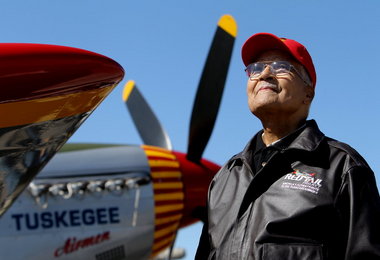CAF Red Tail Squadron Exhibit
|
|
The mission of the CAF Red Tail Squadron is to educate audiences across the country about the history and legacy of the Tuskegee Airmen – America’s first black military pilots and their support personnel – so their strength of character, courage and ability to triumph over adversity may serve as a means to inspire others to RISE ABOVE obstacles in their own lives and achieve their goals.
The CAF Red Tail Squadron’s RISE ABOVE Traveling Exhibit and P-51C Mustang travel 9 months out of the year, crisscrossing the country to deliver this inspirational message. Watch this video to see how school children have been empowered by learning about these fine American heroes, and the enthusiasm educators have for our educational outreach efforts. As the CAF Red Tail Squadron members got to know the real Tuskegee Airmen, they learned many things from the Airmen’s stories about the war and their successful lives afterwards. The Airmen’s experiences are the foundation for the six guiding principles of the Squadron’s RISE ABOVE educational mission. The six RISE ABOVE principles are: Aim High – The men who became known as the Tuskegee Airmen had one goal: They wanted to fight for freedom during World War II. What made them different from the thousands of other men with the same patriotic zeal was that they were black at a time when the U.S. military had no black pilots. Believe In Yourself – In the 1940s, the ignorance of segregation and racial prejudice were a big part of the American landscape. That meant the U.S. military would not give black men a chance to train as pilots. As the country geared for war, President Franklin D. Roosevelt was pressured to change that. In 1941, he ordered the Army Air Corps to set up a program. A segregated flight training base called Moton Airfield was built in Tuskegee, Alabama. The new flight training program at Tuskegee was not expected to succeed. Use Your Brain – Like many military flight cadets, the young men who applied for flight training at Tuskegee were smart. Many had attended college and earned degrees. But it wasn’t easy to get through the program. The first class at Tuskegee had 13 cadets and only five earned their wings. In all, just 996 pilots made it through the Tuskegee program from 1941 to 1945. They learned the skills necessary to be excellent pilots and gained new life skills as well. Never Quit – While in Alabama, they had to live with signs on drinking fountains and theater doors that segregated people into “White” and “Colored.” These black officers had to ignore the insults. They learned to rise above this ignorance and focus on the mission. Be Ready To Go – The Tuskegee Airmen were sent to North Africa and then to Italy to support the Allies’ push into Nazi Germany. From June 1943 until April 1945, 450 Tuskegee-trained pilots flew more than 1500 combat sorties. They flew many kinds of missions, but it was as bomber escorts that the Tuskegee Airmen are most remembered. The 332nd Fighter Group had the tails of their airplanes painted red and soon the white bomber pilots began requesting the “red tail angels” because the Airmen were such skilled pilots and fierce fighters. Expect To Win – As the Tuskegee Airmen destroyed the enemy, they also destroyed the belief that a man should be judged by the color of his skin. Their excellence helped to educate military leaders which resulted in the desegregation of all branches of the U.S. military in 1948. Although it is focused on education, the CAF Red Tail Squadron is not a typical educational program. It uses two unusual tools to create interest in the story of the Tuskegee Airmen. One tool is a rare P-51C Mustang fighter such as the Airmen flew in battle over Europe from during World War II. |




